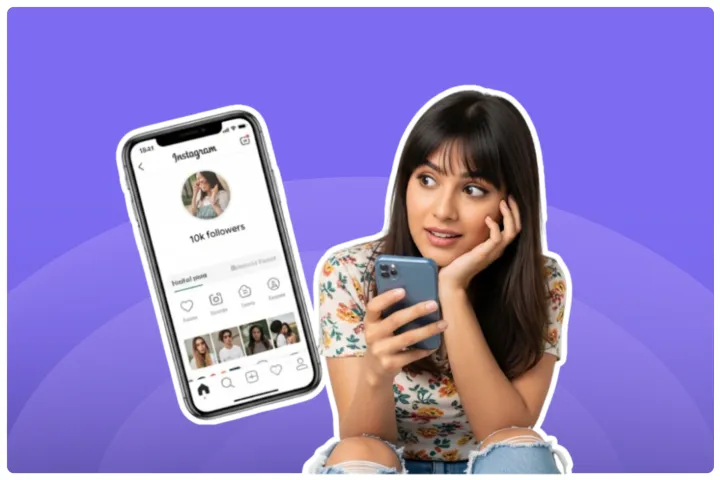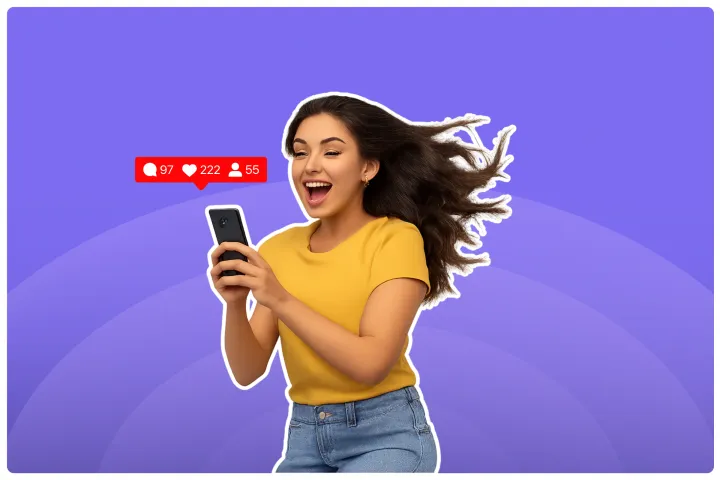What Is Barter Collaboration On Instagram: A Guide (2025)
Curious about barter collaboration on Instagram? Dive into our guide for tips on how to connect, collaborate, and boost your brand without spending a dime!

Ever scrolled through your Instagram feed and seen your favourite creator raving about a new product? Chances are, it might not be a paid promotion. Welcome to the smart and savvy strategy of barter collaborations! If you're a growing brand or an aspiring influencer, this is for you. Let's break down how you can team up and create magic without spending a single rupee.
What Is Barter Collaboration on Instagram?
A barter collaboration on Instagram is an arrangement where a brand offers its products or services to an influencer in exchange for promotional content on their Instagram profile. Instead of a monetary payment (like ₹10,000 for a post), the influencer receives value in the form of goods or experiences.
How is barter collaboration different from traditional paid influencer marketing?
Traditional paid influencer marketing is a straightforward financial transaction. A brand pays an influencer a set fee (or commission) to promote its products or services. These campaigns often have detailed contracts and specific deliverables.
Barter collaborations, on the other hand, are built on mutual benefit and relationship-building. The "payment" is the product or service itself. This makes it a fantastic entry point for smaller brands with limited marketing budgets and for micro-influencers looking to build their portfolios. The focus is more on authentic promotion rather than a direct advertisement.
The Rise of Barter Deals On Instagram
Barter collaborations are becoming increasingly popular, and for good reason. In a world saturated with ads, audiences crave authenticity.
A 2024 study by the Influencer Marketing Hub revealed that 68% of brands use some form of in-kind gifting or barter collaborations, especially when working with micro-influencers.
This trend highlights a shift towards more genuine and trust-based marketing. People trust recommendations from creators they follow and admire, making these partnerships incredibly effective.
Why Barter Collaborations On Instagram Are Popular with Brands
Brands, especially small and medium-sized ones, are loving the barter system. Here’s why:
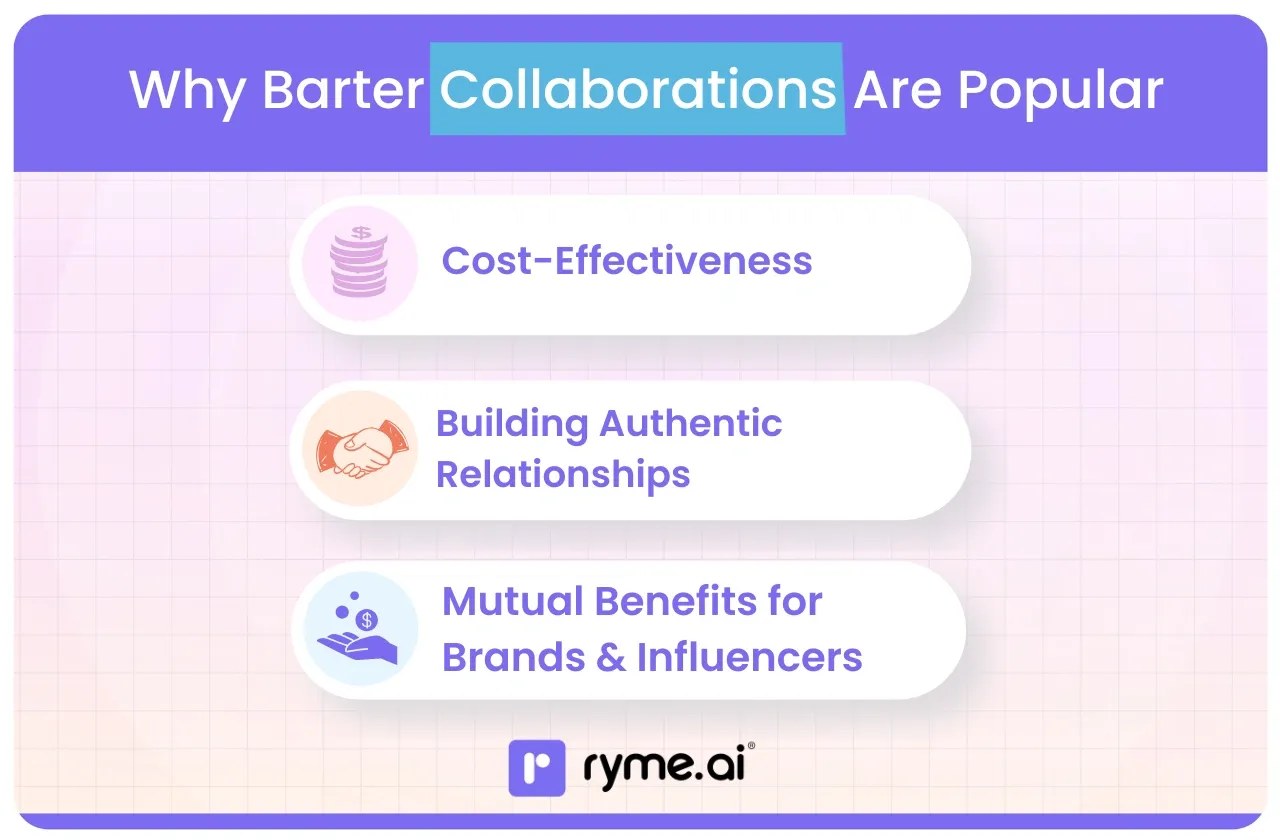
1) Cost-Effectiveness: More Bang for Your (Non-Existent) Buck! 💰➡️🎁
The most significant advantage is the low financial barrier. You can get your product in front of thousands of potential customers without a hefty marketing spend. For a new brand, sending out a ₹2,000 product in exchange for high-quality content and audience reach is a brilliant deal.
2) Building Authentic Relationships: Turning Influencers into Fans 🤝❤️
When an influencer genuinely loves your product, their content reflects that authenticity. A barter deal is often the start of a long-term relationship. A creator who loves your skincare line might continue to post about it long after the initial collaboration, turning them into a true brand advocate.
3) Mutual Benefits: It's a Two-Way Street 🔁
It’s a win-win situation. The brand gets creative content, increased visibility, and valuable social proof. The influencer gets to experience new products, create content for their audience, and build relationships with brands for potential future paid partnerships.
How Barter Collaborations Work on Instagram: Your Step-by-Step Guide
Ready to jump in? Here’s how you can set up your first barter collaboration.
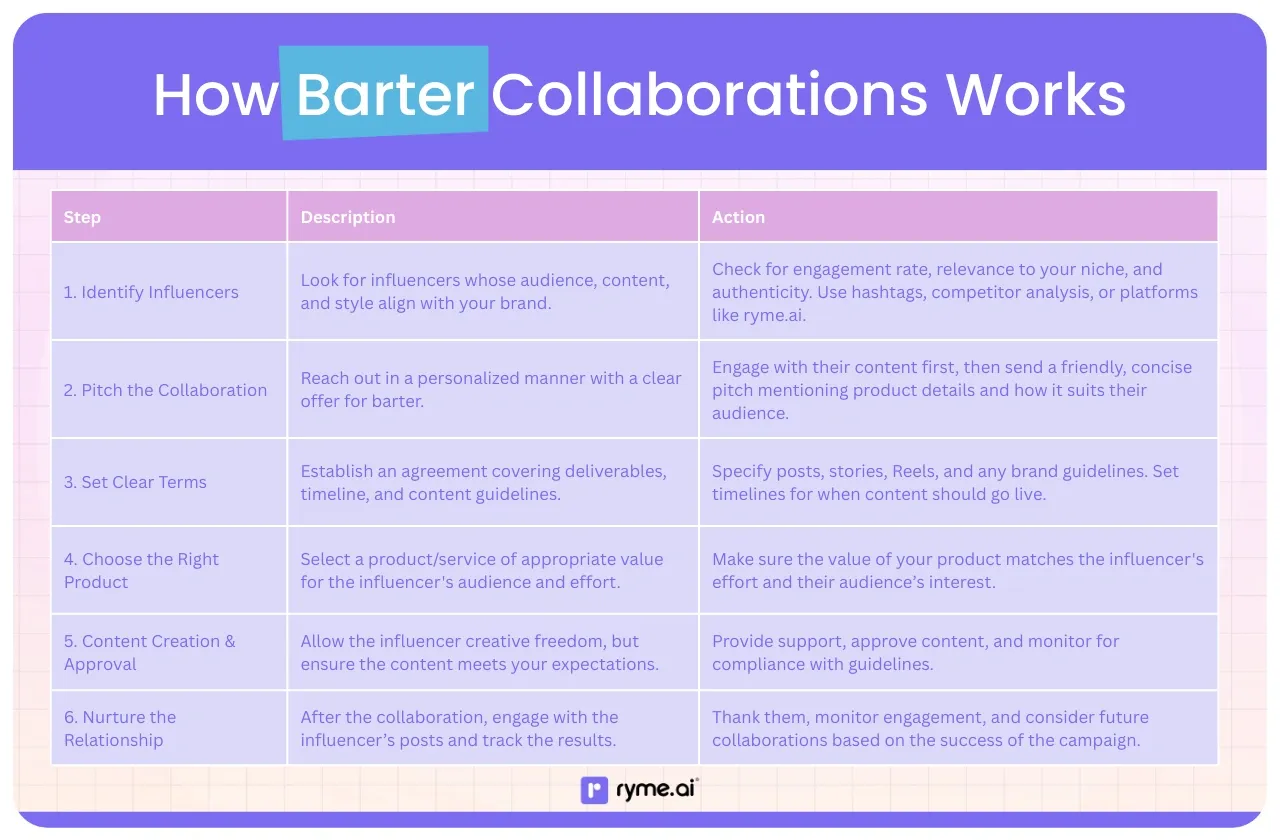
Step 1: Identify Potential Influencers
Look for influencers whose audience aligns with your target market. Don't just look at the follower count. Engagement rate is key! An influencer with 5,000 engaged followers is often more valuable than one with 50,000 passive ones. Tools can help you find influencers in your niche who are open to collaboration.
Step 2: Reaching Out and Pitching the Collaboration
Once you have a list, it's time to reach out. A personalized message works best.
Email/DM Template:
Hey [Influencer's Name],
My name is [Your Name], and I'm the founder of [Your Brand]. I absolutely love your content, especially [mention a specific post you liked]!
I think your audience would really connect with our [Product Name]. It’s a [briefly describe the product and its main benefit].
I’d love to send you one to try out. In exchange, perhaps you could feature it in a post or a few stories if you enjoy it?
Let me know if you’re interested!
Best, [Your Name]
This approach is friendly, respectful, and clearly states what you're offering.
Step 3: Setting Clear Terms (The Agreement) 📝
To avoid any confusion, it's crucial to have a simple agreement in place. This doesn’t have to be a complicated legal document. A clear email outlining the deliverables is often enough for smaller collaborations.
Your agreement should cover:
- What you will provide: The exact product, including size, colour, etc.
- What the influencer will deliver: The number of posts, stories, reels, and any specific hashtags or tags to use. For example: "1 Instagram Reel and 3 Stories."
- Content timeline: When the content should be posted.
- Content usage rights: Clarify if you can reuse their content on your own social media or website. This is a great way to source valuable user-generated content.
Step 4: Determining the Best Product/Service to Offer
Offer a product that is genuinely valuable to the influencer. A generic product might not excite them. Personalize your offer based on their content and interests. If they are a fitness influencer, your new protein bar is a great fit. If they are a beauty blogger, your latest serum is perfect.
Step 5: Content Creation and Approval
Give the influencer creative freedom, but also provide a brief with key messages you’d like them to include. It's a good practice to ask to review the content before it goes live. This ensures it aligns with your brand’s image and messaging.
Step 6: Nurture the Relationship 🌱
After the content is posted, don't just disappear! Thank the influencer, engage with their post, and stay in touch. A positive experience can lead to more collaborations down the line, some of which may even become paid partnerships as your brand grows.
Benefits of Barter Collaborations On Instagram for Small and Medium Brands
If you're a small or medium brand, here’s how you can win with barter deals.
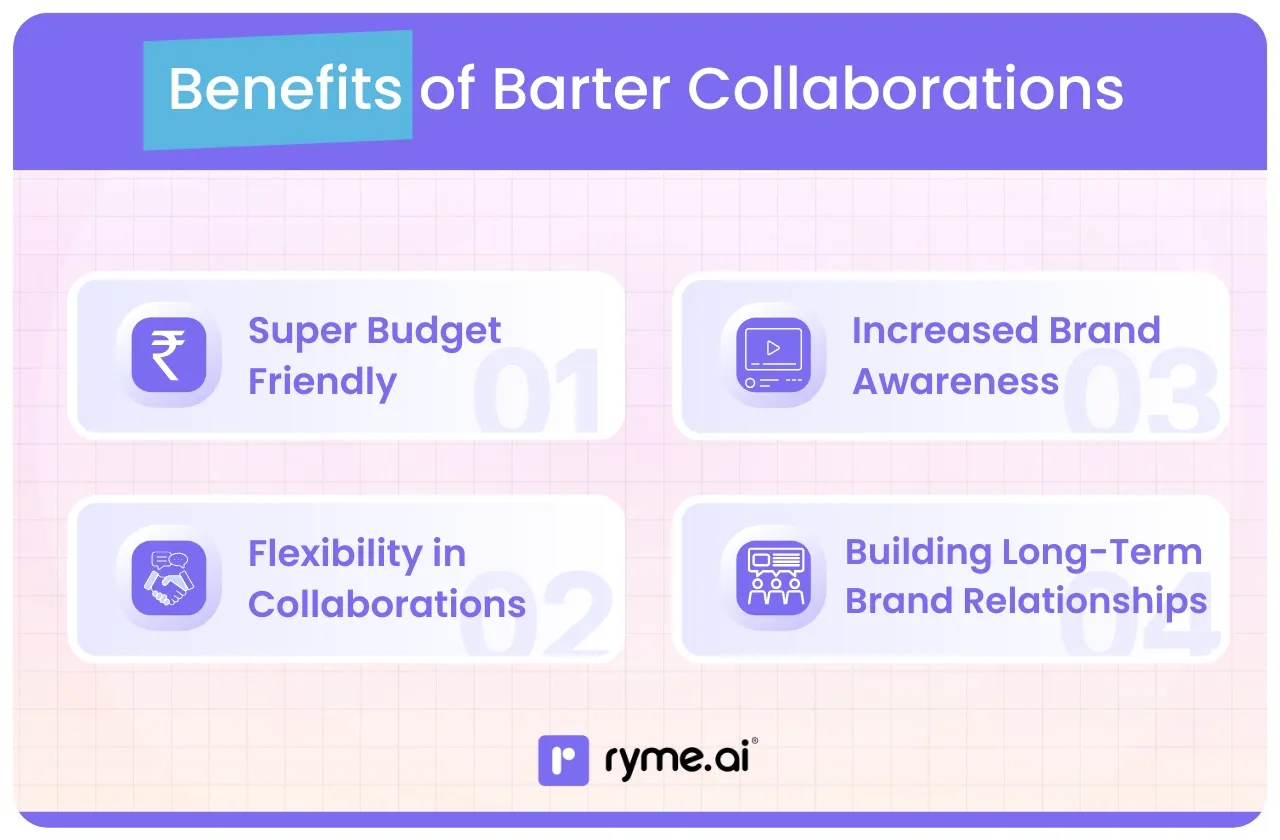
1) Super Budget-Friendly: Marketing Power Without the Price Tag 💸🚫
You can launch a full-fledged influencer campaign with minimal cash outlay. Your main cost is the product itself. This frees up your budget for other essential areas of your business.
2) Increased Brand Awareness: Reach New Eyes Organically 👀
Influencers can introduce your brand to a targeted audience that you might not have been able to reach otherwise. This organic placement feels more trustworthy than a traditional ad.
3) Flexibility in Collaborations: Choose Your Perfect Match 🧩
You have the freedom to work with multiple micro-influencers instead of putting all your budget into one large influencer. This allows you to test different niches and see what works best for your brand. This flexibility is key to understanding the impact of influencer marketing on consumer behaviour.
4) Building Long-Term Brand Relationships: Create a Community of Advocates 🫂
Barter deals are the perfect foundation for building a loyal community of brand ambassadors who will support you as you grow.
Potential Challenges with Barter Collaborations On Instagram (and How to Navigate Them!)
It's not always smooth sailing. Here are some common bumps in the road and how to handle them.
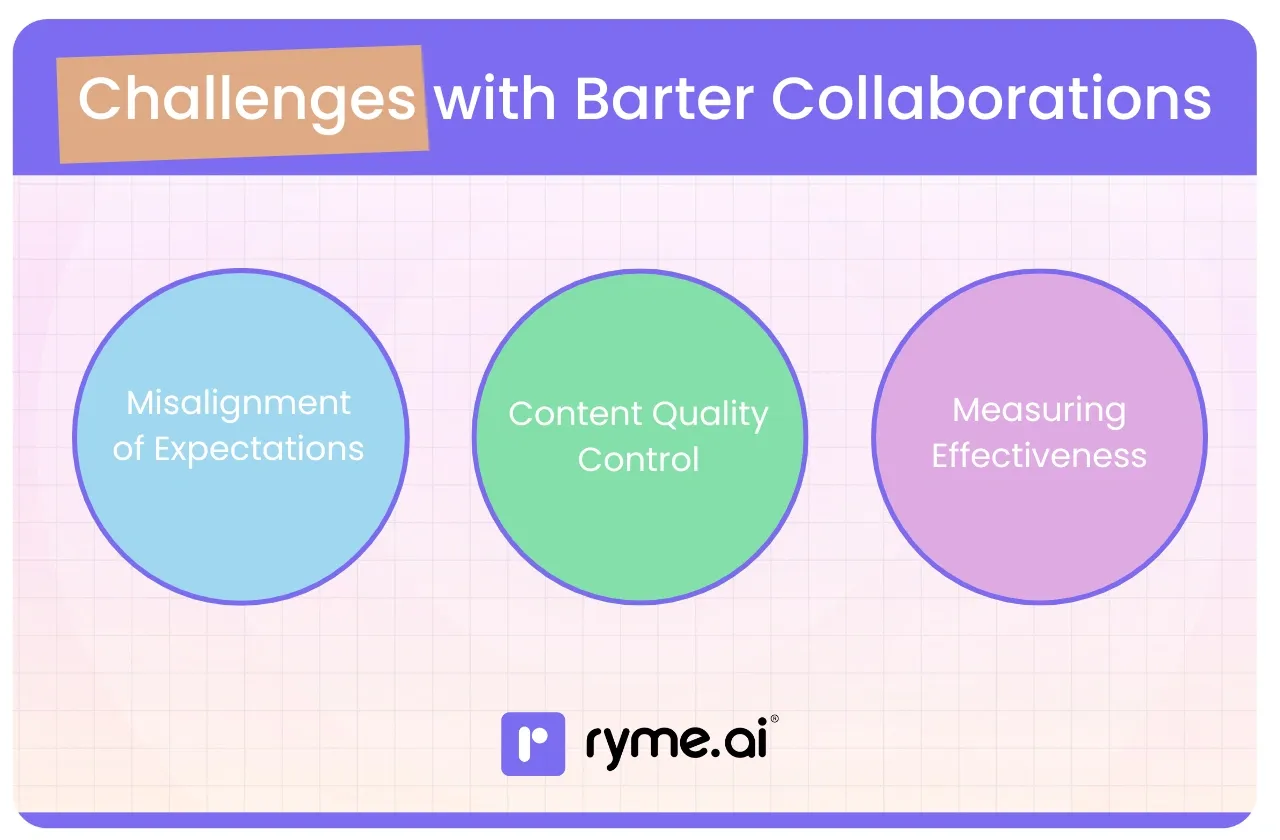
1) Misalignment of Expectations: "Wait, I Thought You Meant..." 😬
The Problem: The influencer posts a single, low-quality story when you were hoping for a beautiful feed post. The Solution: A clear agreement! Putting everything in writing from the start prevents misunderstandings.
2) Content Quality Control: "Uh Oh, That Doesn't Look Like My Brand..." 🖼️≠🎨
The Problem: The content created doesn't match your brand's aesthetic. The Solution: Provide a clear mood board and brand guidelines. Ask for content approval before it's posted.
3) Measuring Effectiveness: "Is This Actually Working?" 📊❓
The Problem: You don't know if the collaboration drove any sales or traffic. The Solution: Use unique discount codes or trackable links for each influencer. This helps you measure the ROI of each partnership.
Leveraging ryme.ai for Efficient Influencer Management
Managing multiple barter collaborations can get messy. This is where a platform like ryme.ai can be a game-changer.
1) Zero-Commission, No-Budget-Limit Model: Keep More Value in Your Pocket
ryme.ai operates on a model that lets you run your campaigns without worrying about commissions eating into your value. You can manage barter deals of any scale without budget limitations.
2) AI-Powered Influencer Matching: Find Your Perfect Fit, Faster 🎯
Stop spending hours scrolling through Instagram. The AI-powered tools on ryme.ai help you find the right influencers for your brand in minutes, not days.
3) Real-Time Insights and Analytics: Finally, Measure Your Barter Success! 📈
Track your campaign performance with real-time analytics. Understand your reach, engagement, and ROI all in one place.
4) Streamlined Content Approval Workflows: No More Email Chaos 📧➡️✅
Manage content submissions, feedback, and approvals through a single, streamlined dashboard.
5) Affordable Scalability: Grow Your Campaigns as You Grow
ryme.ai is designed to scale with you. Whether you're running five collaborations or fifty, the platform makes it manageable and affordable.
Best Practices for Managing Barter Collaborations with Influencers On Instagram
Here are some final tips to ensure your collaborations are a resounding success.
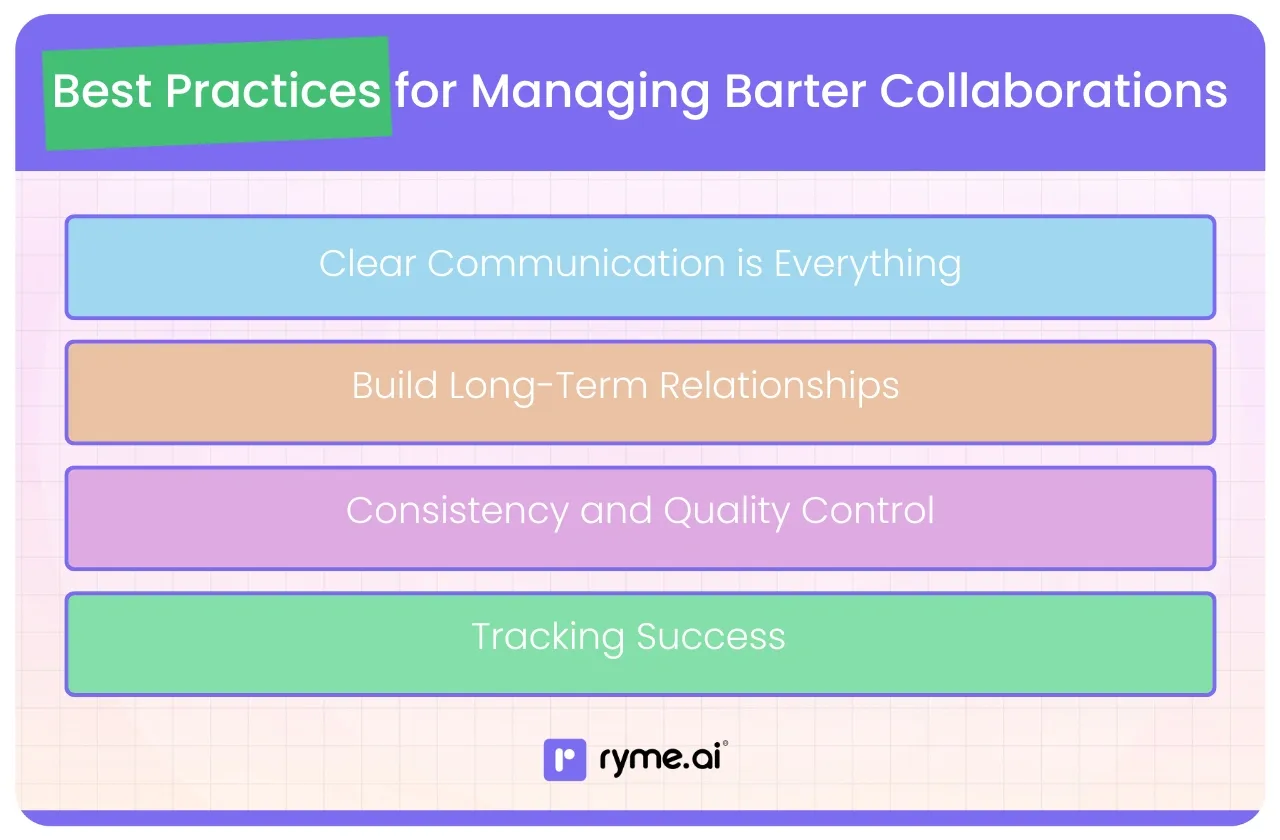
1) Clear Communication is Everything (Seriously!) 🗣️💬
Be upfront, be clear, and be responsive. Good communication is the bedrock of any successful partnership.
2) Build Long-Term Relationships: Think Beyond the Single Post ⏳🤝
The goal is to create brand fans. Nurture your relationships, and you'll build a powerful network of advocates.
3) Consistency and Quality Control: Maintaining Brand Standards ✨
Ensure the influencer's content aligns with your brand's voice and values. Consistency builds brand recognition and trust.
4) Tracking Success: Know What's Working 🎯✔️
Use analytics to understand what’s driving results. Double down on what works and refine your strategy over time. Knowing how much influencers charge in India can also provide context for the value you are getting.
Conclusion
Barter collaborations on Instagram offer a powerful and cost-effective way for brands to grow and for influencers to build their portfolios. By focusing on authentic relationships and mutual value, you can create impactful campaigns that resonate with audiences. So go ahead, reach out, and start building those partnerships!
Instagram Barter Collab Related FAQs
1) What is the barter system in collaboration?
The barter system in collaboration is an exchange of goods or services for promotion and content, without any monetary payment. A brand provides a product, and the influencer provides exposure in return.
2) How to get barter collaboration on Instagram?
To get a barter collaboration, identify influencers in your niche, and send them a personalized pitch offering your product in exchange for content like a post or story. Make sure your product is a good fit for their audience.
3) What is barter on Instagram?
Barter on Instagram refers to a partnership where a brand gives an influencer a product or service for free, and the influencer promotes it to their followers on the platform. It’s a non-monetary collaboration.
4) How to reply for barter collaboration?
If you're an influencer, reply professionally. Thank the brand for their interest. If you like the product and the terms are fair, express your excitement to collaborate. If you need to negotiate, be clear about what you'd expect (e.g., "I'd be happy to create one Reel and two stories in exchange for the product."). If you're not interested, decline politely.
Instagram Barter Collaboration Checklist: Key Takeaways
Ready to kickstart your barter journey? Keep this checklist handy:
✅ Define Your Goals: What do you want to achieve? (Awareness, content, engagement?)
✅ Identify the Right Influencers: Focus on relevance, engagement, authenticity, and audience match.
✅ Personalize Your Pitch: Show you've done your homework. Clearly state it's a barter proposal.
✅ Offer Fair Value: Ensure the product/service value matches the content ask.
✅ Create a Clear Agreement: Detail deliverables, timeline, guidelines, usage rights, and disclosures (put it in writing!).
✅ Provide Brand Guidelines: Keep content consistent and on-brand, but allow creative freedom.
✅ Consider an Approval Process: Review content before it goes live (optional, but recommended for quality control).
✅ Track What You Can: Use UTM links, unique discount codes, and monitor engagement/reach.
✅ Leverage Tools: Consider platforms like ryme.ai to streamline finding, managing, and analyzing collaborations.
✅ Communicate Clearly & Promptly: Be responsive and professional.
✅ Nurture Relationships: Thank influencers, engage with their content, and consider them for future opportunities.
✅ Comply with Guidelines: Ensure influencers use clear disclosures (#ad, #gifted).
✅ Review & Iterate: Learn from each collaboration to improve your strategy.


